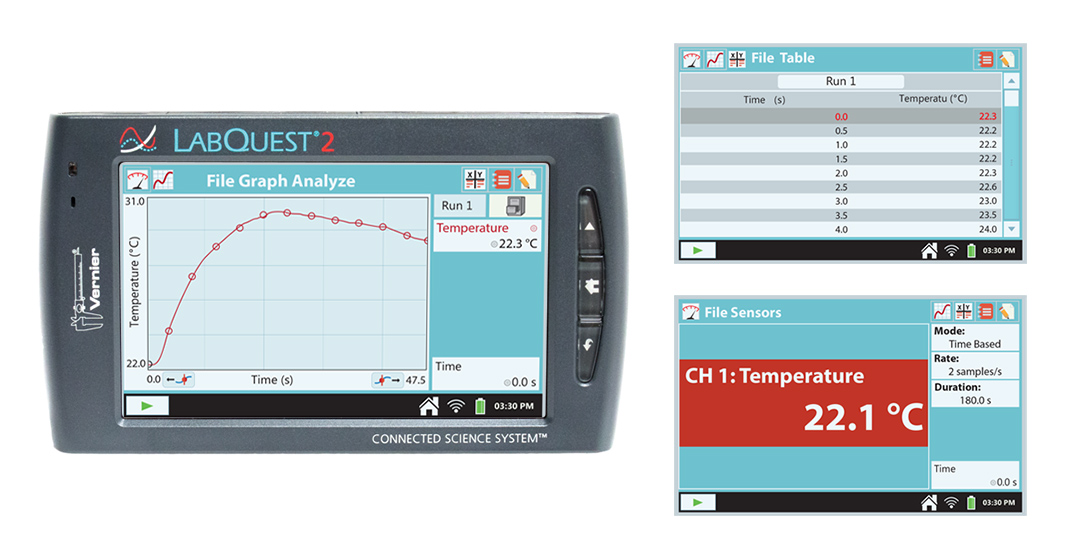 If you saw the introductory video for Biology (5th edition), you heard Rachel mention that the new lab manual uses probeware. (If you haven’t seen the video, you can check it out here.)
If you saw the introductory video for Biology (5th edition), you heard Rachel mention that the new lab manual uses probeware. (If you haven’t seen the video, you can check it out here.)
What is probeware?
Probeware is an exciting technology that measures a variety of factors using probes and sensors attached to a handheld interface. Despite the value of lab work, the price of the testing equipment and sensors can be a major impediment. Especially for homeschool families.
Probeware allows your child to detect or measure carbon dioxide, or to measure temperature and pH. But most importantly, probeware allows students to record a series of data points in a spreadsheet for analysis.
This may all sound rather technical, so let me explain how probeware adds value to your homeschool. Probeware allows you to buy one or two devices that can be used in a variety of experiments. It will make your students’ lab experience much more interactive. Generally much simpler to use than the instruments it replaces, probeware makes it easier to incorporate STEM into your curriculum.
How do you use probeware?
Lab 20A in Biology (5th edition) is an inquiry lab that uses probeware to compare how well areas of human skin can recover from cold. A high school student using a more traditional method would measure the temperature from each area of skin using a thermometer, record the temperature on paper or in a spreadsheet, and then repeat the process. But meaningful data requires a number of data points, so the lab time would have to be extended, or the number of areas of skin would have to be limited, possibly to as few as two.
Probeware eliminates this problem by automatically recording the data at a set time interval, giving the student a helpful number of data points in a short time. The student can then move on to the next area of skin. In this way, a student can test more areas in less time and with fewer mistakes. While a thermometer would work, probeware makes this lab more accurate, faster, and—I think your teen will agree—more fun.
What are the different types of probeware?
We wrote our skin temperature lab to be used with the Vernier LabQuest probeware system. Recently, we were introduced to the Globisens Labdisc. This system could also be used for the skin temperature lab without any problem. By researching and working with both systems, we discovered the strengths and weaknesses of each one.
Vernier LabQuest
Vernier LabQuest is a high-quality high school and college level system featuring well-built and easy-to-use probes and a separately sold interface. It makes two interfaces (the LabQuest® 2 and the LabQuest® Mini) and dozens of individual probes. This makes the LabQuest® highly customizable, allowing the user to purchase only the probes needed. The downside of this product is the price. While not unusual for this type of device, a price tag of $329 for each LabQuest® 2 interface probably isn’t realistic for the average homeschool family. Vernier also offers a less sophisticated LabQuest® Mini for $149. Individual probes range in cost from $29 to $299.
Globisens Labdisc
Rather than using a single interface and dozens of separate probes, Globisens Labdisc integrates most of the sensors directly into the interface and includes any additional probes in a single package. Labdisc comes in four versions:
- GenSci—designed for general science
- Enviro—for environmental science
- BioChem—for biology and chemistry
- Physio—for physics
The units cost $599 apiece, with the exception of the BioChem unit, which retails for $699. For many homeschool families, the price (significantly cheaper than the combined cost of a LabQuest interface and individual probes) makes Labdisc more cost effective.
Its two main downsides are lower quality and lack of customization. The Labdisc unit’s plastic shell feels brittle. Given the wear and tear a unit is likely to experience in the hands of middle and high school students, a Labdisc unit may not hold up well over the long term. Secondly, integrating the sensors directly into four separate interfaces makes customization impossible. If you find that your unit does not contain a sensor you need, you have to purchase an entire unit rather than just an additional probe.
Summary
If you’re considering buying probeware for your high school student, either of these would be a good purchase. However, if your budget is tight and you don’t need a lot of customization, the Labdisc might be right for you. If money is less of an object and you value quality and customizability, you might find the LabQuest to be just what you’re looking for.
• • • •
Elwood holds a BA in biology and an MA in English from Bob Jones University. After working with the video lesson department at BJU Press for five years, he now serves as a secondary-level science writer at BJU Press. When not working, he enjoys taking random college classes, reading, playing disc golf, and hanging out with his wife and three kids.

 One morning, my second-grade daughter was taking a heritage studies test when she complained, “Mom, this question doesn’t make sense.”
One morning, my second-grade daughter was taking a heritage studies test when she complained, “Mom, this question doesn’t make sense.”
